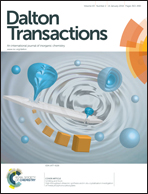Design and fabrication of a series of metal-mediated assemblies with tetrapyridylporphyrins for supramolecular solar cells†
Abstract
In this work, a metal-mediated assembling strategy has been used to organize a series of new assemblies based on tetrapyridylporphyrin (ZnP) on nanostructured TiO2 electrode surfaces, wherein the metal ions (M, M = Zn2+, Cd2+, Hg2+ and Mn2+) bridge the pyridyl units of ZnP and (E)-4-[(pyridin-4-ylmethylene)-amino]benzoic acid (A), resulting in a ZnP–M–A assembled mode. The assembled structures were characterized by transmission electron microscopy (TEM), computational calculations, energy-dispersive X-ray spectroscopy (EDX), IR, UV-vis absorption and fluorescence spectra. The performances of the assembly-sensitized solar cells were also measured under an irradiance of 100 mW cm−2 AM 1.5G sunlight. Photoelectrochemical results reveal a relatively large photocurrent of the ZnP–Mn–A device. Simultaneously, a large open-circuit photovoltage and a significantly improved conversion efficiency of the ZnP–Zn–A device are also observed. These findings may serve as another good testing ground for the fabrication of supramolecular solar cells in future.


 Please wait while we load your content...
Please wait while we load your content...